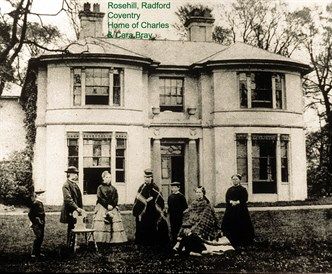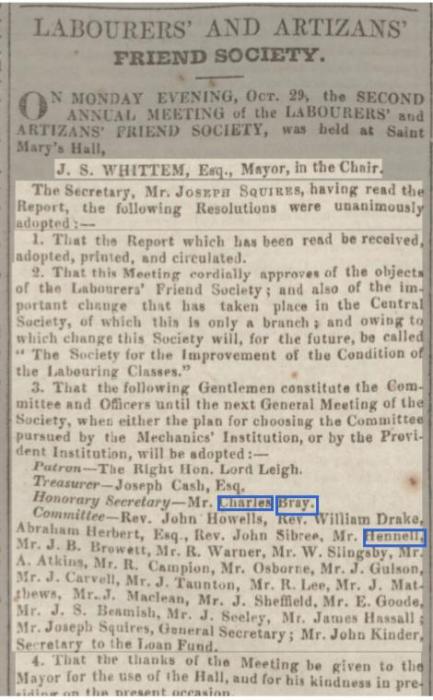|
Prof
Gloucester Thread starter
|
16 of 23
Wed 22nd Apr 2020 10:35am
Post 9 in this thread. Sorry Kaga, yes, she was sympathetic as she learned Hebrew when writing Daniel Deronda but this says she was not Jewish. (Would have to be through her mother's ancestry.)
29/05/2012. The Jewish Odyssey of George Eliot by Gertrude Himmelfarb. It is one of the curiosities of history that the most remarkable novel about Jews and Judaism, predicting the establishment of the Jewish state, should have been written in 1876 by a non-Jew - a Victorian woman and a formidable intellectual, who is generally regarded as one of the greatest of English novelists. |
| Local History and Heritage - George Eliot | |
|
Kaga simpson
Peacehaven, East Sussex |
17 of 23
Thu 23rd Apr 2020 10:07am
Prof,
She never really knew, dark haired, Jewish nose, not able to find out, near the end of her life, she had to find out about Jewish life - she had a Jewish friend, read everything she could about Jews. She had to write one last book so she made it about Jewish families and full of Jewish names, 'Daniel Deronda', an expression of her own idealism. |
| Local History and Heritage - George Eliot | |
|
Prof
Gloucester Thread starter
|
18 of 23
Thu 23rd Apr 2020 10:44am
Well Kaga, I suppose that is a possibility! |
| Local History and Heritage - George Eliot | |
|
Prof
Gloucester Thread starter
|
19 of 23
Wed 3rd Jun 2020 10:55pm

|
| Local History and Heritage - George Eliot | |
|
Kaga simpson
Peacehaven, East Sussex |
20 of 23
Thu 4th Jun 2020 12:56pm
Charles Bray, born 1811 bought Rosehill in Radford in 1840. His father, a very, very rich man, had died in 1835, left eight children very well off and a weaving factory in Coventry. They still had a country house, horses, carriage, dogs. Charles had been to boarding school, and was of learned culture.
George Eliot lived close by in Foleshill, also educated, seen at his house often - along with religion they studded phrenology (thought they could tell a person's ability by the shape of their head), also women's rights.
The weaving and ribbon trade was seasonal, little on Monday or Tuesdsy..
Next in status was the master weavers, most owned a house, tools and workshop; next were foremen, then the mass, journeymen, apprentices, women folk, and children helped with the weaving and winding, all wretchedly poor, often starving.
Normal winter working was Wednesday to Friday, a long working day. In 1819 the weekly wage was close to 18/- a week, in 1832 it had been cut to 11/- shillings a week. Riots broke out, starvation and disease spread.
|
| Local History and Heritage - George Eliot | |
|
Malvern
Somerset |
21 of 23
Tue 14th Jul 2020 12:17pm
I've just re-read Middlemarch after 40 odd years. in the knowledge that it may be a fictionalised Coventry and also in light that I have been investigating my 3rd and 4th great grandfather's lives in Coventry in the period referred to.
George Eliot lived in Coventry with her father, Robert, a land agent (another occupation which features in the novel), between 1841 and 1850. They lived at Bird Grove just off Foleshill Road (now George Eliot Kindergarten in George Eliot Road) and was friends with Charles Bray of Rosehill (which stood between Radford Road and St Nicholas Street) and although the novel is based in 1829-1832, I think I have spotted a number of references to Coventry of the 1840s in the book.
As far as placing Middlemarch geographically and fixing locations within Coventry the most noticeable is the meeting in the entrance to the yard outside the Green Dragon in the High Street referred to in Chapter 71. There is reference to the "the Riverston Coach" appearing in the distance. Riverston is perhaps the most obviously identifiable place as there is a comment "...a mansion near Riverston already furnished in a high style by an illustrious Spa physician. Leamington Spa. From 1838 the terminus for coaches to Leamington, Warwick and Stratford-upon-Avon was the Craven Arms in High Street, prior to that both the regional and national coaches stopped at the City Hotel in Broadgate. The billiards hustling scene also takes place at the Green Dragon. Loamford, the county town of Loamshire houses the military barracks and is identifiable with Warwick. As towns and cities are located father away form the action and the protagonists they become real - London, Paris, Rome, Durham, York, Cheltenham etc.
The Craven Arms was the Whig-Radical party headquarters in the 1830s and 40s. In 1836 the Coventry Standard (The Tory newspaper) gives a rather disparaging account of a meeting which took place there. The Chairman of the meeting was H Merridew, who was the brother of Nathaniel Merridew, the owner of the Coventry Herald and Observer (The Whig newspaper). In Middlemarsh the two Newspapers were "The Trumpet" (Herald) and "The Pioneer" (Standard). In 1846 the Herald was bought by Charles Bray and he published some of Mary Ann Evans early writings in the newspaper. "The Trumpet" and its owner and editor play an important part in the novel.
Politically the book is very definitely Coventry with references to the freemen, alderman, and the Municipal Reform, which although they existed in many towns were extremely prominent in Coventry.
Looking at my family's links there is also a reference to the "Tankard Inn Benefit Club". "The Tankard" is the other pub which is mentioned in Middlemarch and is where the ordinary townsfolk meet to drink and gossip. I recently raised another topic on here on the Shakespeare Inn Benefit and Dividends Club and Benevolent Society (est.1819) as one of my ancestors was a Steward. I've also now found another society from 1844.
 The names include Charles Bray - Secretary, Mr Hennell (Charles Bray's father-in-law of brother-in-law) and the Rev John Sibree (minister of Vicar Lane Chapel. The J Carvell referred to is either James (a watch finisher) or Joseph (a tailor), one of my 5th great uncles. There is also an article from 1837 regarding the establishment of the Coventry Self Supporting Dispensary, which includes a number of the same names as members. How physicians funded themselves through prescribing drugs is something else which features heavily in Middlemarch.
When my 3rd great grandfather had his run in with the Town Council in February 1843, the Mayor at the time was Abijah Pears, who was another of Charles Bray's brothers-in-law.
It seems to me that George Eliot went out of her way to try not to identify Middlemarch with Coventry, possibly as not to offend Coventrians as some of her comments about the townspeople of Middlemarch are quite scathing, but also to make the story more generic and universal. It's pretty certain that whilst the story is purely fictional, much of the characteristics and activities of the novel rely heavily on real people and events, which George Eliot experienced.
The names include Charles Bray - Secretary, Mr Hennell (Charles Bray's father-in-law of brother-in-law) and the Rev John Sibree (minister of Vicar Lane Chapel. The J Carvell referred to is either James (a watch finisher) or Joseph (a tailor), one of my 5th great uncles. There is also an article from 1837 regarding the establishment of the Coventry Self Supporting Dispensary, which includes a number of the same names as members. How physicians funded themselves through prescribing drugs is something else which features heavily in Middlemarch.
When my 3rd great grandfather had his run in with the Town Council in February 1843, the Mayor at the time was Abijah Pears, who was another of Charles Bray's brothers-in-law.
It seems to me that George Eliot went out of her way to try not to identify Middlemarch with Coventry, possibly as not to offend Coventrians as some of her comments about the townspeople of Middlemarch are quite scathing, but also to make the story more generic and universal. It's pretty certain that whilst the story is purely fictional, much of the characteristics and activities of the novel rely heavily on real people and events, which George Eliot experienced.
Malvern
|
| Local History and Heritage - George Eliot | |
|
Kaga simpson
Peacehaven, East Sussex |
22 of 23
Tue 14th Jul 2020 3:38pm
Malvern,
Middlemarch came out in eight serial books in newspaper form during 1871/2, and Eliot left Coventry in 1851. The book asks us to compare different ways of interpreting life, but it was the Nuneaton Riot of 1832 she remembered most.
It was her physical plainness that bugged her. She was longing to stand out from the mass, but so we're other women - Gaskell, Bronte, etc. All of these books were of the same theme, so was Hardy, Dickens, and Sand.
The adulation which followed the success of the book was overwhelming, and she often escaped to the continent.
Middlemarch meant little to most Coventry people for they could neither read or write, but the townspeople weee aware of the degrees of rank and subtleties of status.
Confrontation between Whig and Tory, church and chapel, constraints of its people. Charles Bray, Hennel, and all the other mill and factory owners, made salaried committees, to help and feed the poor. They made rules on wages knowing full well they weren't going to pay them. They were the aristocrats and along with the clergy ruled the country.
Bray could afford a loaf of bread to feed his hens and ducks, yet a spinner or weaver stole a loaf of bread to feed his starving kids, and he could find himself transported. There was a lot wrong with the balance of Coventry during the Victorian era. |
| Local History and Heritage - George Eliot | |
|
Prof
Gloucester Thread starter
|
23 of 23
Tue 20th Sep 2022 9:47pm
Just re-found an Arena TV programme re George Eliot. I am sure I have watched it before. 'Everything is Connected - George Eliot's Life!' - scenes of childhood home, Griff House, Bird Grove, Holy Trinity, etc. Many biographical details and quotes from her writings. |
| Local History and Heritage - George Eliot | |
Website & counter by Rob Orland © 2024
Load time: 442ms